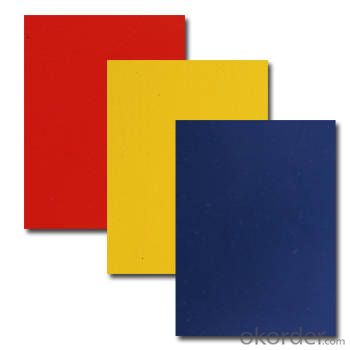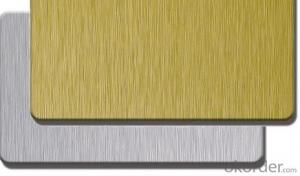Aluminium Compoosite Pannel for Insulation Application
- Loading Port:
- Shanghai
- Payment Terms:
- TT OR LC
- Min Order Qty:
- 8 m.t.
- Supply Capability:
- 1000 m.t./month
OKorder Service Pledge
OKorder Financial Service
You Might Also Like
Item specifice
Structure of Aluminium Compoosite Pannel for Insulation Application Description:
Coated aluminum coil/sheet are of a wide range of colors, which gives wonderful appearance no matter in residential and commercial constructions of great exhibition centers.
The coated aluminum coil/sheet have been widely used in the fields of construction and decoration( garage doors, ceiling etc.), electronic appliances, lighting decoration, air-condition air pipes, sandwich panels and drainages etc.
Main Features of the Aluminium Compoosite Pannel for Insulation Application:
1) High flexibility
2) Impact resistance
3) Excellent weather-proof durability
4) Anti-ultraviolet
5) High erosion resist
Images of the Aluminium Compoosite Pannel for Insulation Application:



Aluminium Compoosite Pannel for Insulation Application Specification:
Alloy | A1100,A3003,A1050,A8011 etc |
Temper | H16,H18,H24 |
Thickness | From 0.024mm to 1.2mm |
Width | Standard width:1240mm |
Special width:1300mm,1520mm,1570mm,1595mm | |
Diameter | Standard dia:1200mm |
Interior dia:150mm,405mm,505mm | |
Weight | 2.5 T/coil,3.0 T/coil |
Coating | PE, PVDF, AC |
Surface | Embossed, mill finish, coated |
Color | AS to code RAL |
Gloss | 10-90%(EN ISO-2813:1994) |
Coating Thickness | PE: more than 18 micron |
PVDF: more than 25 micron | |
Coating Hardness (pencil resistance) | More than 2h |
Coating adhesion | 5J(EN ISO-2409:1994) |
Impact Resistance | No peeling or cracking(50 kg/cm,ASTMD-2794:1993) |
Flexibility (T-bend) | 2T |
MEK resistance | More than 100 |
FAQ:
a.What is monthly capacity
---CNBM is one stated own company and our monthly capacity is about 2000tons.
b. Now which countries do you export your goods?
---Now we export to South East Asia,Africa, North America,South America ect.
- Q:What are the advantages of using aluminum sheets in the packaging industry?
- There are several advantages of using aluminum sheets in the packaging industry. Firstly, aluminum is a lightweight material, which makes it easier to handle and transport. Secondly, aluminum is highly resistant to corrosion, ensuring the protection of the packaged products. Additionally, aluminum has excellent barrier properties, providing a strong barrier against light, moisture, and oxygen, thus extending the shelf life of the packaged goods. Moreover, aluminum is malleable, allowing for easy shaping and customization of packaging designs. Lastly, aluminum is recyclable, making it a sustainable choice for the packaging industry and contributing to environmental conservation efforts.
- Q:How do you clean aluminum sheets?
- To clean aluminum sheets, you can start by rinsing them with water to remove any loose dirt or debris. Then, create a mixture of mild dish soap and warm water. Use a soft cloth or sponge to gently scrub the aluminum sheets with the soapy solution. Avoid using abrasive cleaners or scrub brushes, as they can scratch the surface of the sheets. Once you've thoroughly cleaned the sheets, rinse them again with water and dry them with a clean towel or cloth.
- Q:on an hot day, which will stay cooler longer...aluminum, or copper? why?thanks!
- copper aluminum’s conductivity is lower than copper.
- Q:What are the standard sizes and availability of aluminum sheets in the market?
- The sizes and availability of aluminum sheets in the market can vary depending on the location and specific requirements. Nevertheless, there are generally available sizes that can be found in most markets. In terms of thickness, aluminum sheets are commonly found in the range of 0.02 to 0.2 inches (0.5 to 5 millimeters). Thinner sheets (0.02 to 0.06 inches) are often utilized for lightweight purposes such as signage or crafts, while thicker sheets (0.1 to 0.2 inches) are typically employed for more heavy-duty applications like construction or industrial use. Regarding width and length, standard sizes of aluminum sheets are often offered in 4 feet by 8 feet (48 inches by 96 inches) or 4 feet by 12 feet (48 inches by 144 inches). These dimensions are widely available and suitable for various applications. However, it is important to note that custom sizes can also be ordered or cut from larger sheets to meet specific project requirements. Aluminum sheets can be found in various locations, including local hardware stores, metal suppliers, and online marketplaces. It is always advisable to check with local suppliers or conduct online research to determine the specific sizes and availability in your area. Additionally, different grades or alloys of aluminum may have varying availability, so it is crucial to consider the specific requirements of your project when sourcing aluminum sheets.
- Q:Are aluminum sheets suitable for food packaging?
- Yes, aluminum sheets are suitable for food packaging. Aluminum is a highly versatile and widely used material in the food industry due to its unique properties. It is lightweight, flexible, and has excellent barrier properties that protect the contents from external factors such as moisture, light, and oxygen. These properties help to maintain the freshness and quality of food products. Additionally, aluminum is resistant to corrosion and does not react with acidic or alkaline substances, ensuring that the taste and quality of the food is preserved. Furthermore, aluminum sheets can be easily shaped into different forms, making them ideal for various types of food packaging such as trays, containers, and foil wraps. Overall, aluminum sheets are a safe and effective choice for food packaging, providing durability, protection, and convenience.
- Q:Can aluminum sheets be used for roofing applications?
- Yes, aluminum sheets can be used for roofing applications. Aluminum is a lightweight and durable material that offers excellent resistance to corrosion. It is particularly suitable for areas with high humidity or coastal regions where saltwater exposure is common. Aluminum roofing sheets are known for their longevity and low maintenance requirements. They are also fire-resistant and can withstand extreme weather conditions, making them a popular choice for both residential and commercial roofing projects. Additionally, aluminum sheets are easy to install and can be shaped and formed to fit various roof designs. Furthermore, aluminum is a sustainable material as it can be recycled repeatedly without losing its quality, making it an environmentally friendly option for roofing applications.
- Q:Can aluminum sheet be used for food contact applications?
- Indeed, aluminum sheet is suitable for food contact applications. The food industry extensively utilizes aluminum owing to its exceptional characteristics. It is non-toxic, resistant to corrosion, and possesses a high thermal conductivity, rendering it appropriate for an array of food processing and packaging purposes. By utilizing aluminum sheets, one can craft food containers, trays, and foils, thereby offering a secure and sanitary solution for storing and transporting food. Moreover, aluminum is recyclable, making it an environmentally conscious selection for food contact applications.
- Q:If one were to hit someone with a baseball bat, would it cause more pain to use a wooden bat or an aluminum one? Just wondering.
- I've been chased with an aluminum bat, but haven't ever been hit with either. I would say that the wooden bat would hurt more, because that's solid wood. An aluminum bat is hollow. But then yet, I've red articles where aluminum bats perform better for some kind of scientific reason that I didn't quite understand. So if an aluminum bat performs better on a baseball, it would be safe to assume that perhaps it would hurt more to be hit with an aluminum one. But either way, it's safe to say... I'd rather not be hit with either!
- Q:Can aluminum sheets be used for protective enclosures?
- Aluminum sheets have the ability to be utilized for protective enclosures. This material, known for its versatility and lightweight nature, offers exceptional durability and resistance to corrosion. It can easily be transformed into various shapes and sizes, making it suitable for constructing protective enclosures across a wide range of applications. Industries such as electronics, telecommunications, aerospace, and automotive commonly employ aluminum enclosures, which safeguard against environmental factors like moisture, dust, and electromagnetic interference. Moreover, these enclosures can be further improved with the addition of coatings or insulation materials to meet specific requirements for thermal insulation, fire resistance, or electrical conductivity. All in all, aluminum sheets are a dependable option for protective enclosures due to their strength, adaptability, and capacity to endure challenging conditions.
- Q:Hi,I'm building a tricycle for 2 passengers as well as the rider.My main concern for the structure of the chassis is the junction between the rear and the bike frame. Both structures on their own withstand the weight when made out of aluminium, no need to go for steel. But what about that junction? Will aluminium have a propensity to buckle? should i used double tubing or a fork design? I suppose the shape and caliber of the tube also comes into play.Lastly, which of a tube or cylindrical rod is stronger?ThanksAddendum: I'm looking at aluminium because it's cheaper and for weight reduction in the vehicle.
- You cannot weld steel to aluminum with traditional arc welding techniques. It can only be done with explosion or friction welding. I doubt either of these processes will be utilized on a trike frame as they would be cost prohibitive for low production runs. Are you an experienced aluminum welder, or will you be using one? If not, I'd suggest using steel tubing. Steel is much more forgiving during the welding process. It is stronger too; although on the downside, it is heavier. As for your design, it is very difficult to follow your description without a picture. I would be remiss to suggest something with my current, limited understanding. As far as tubing and solid rod are concerned, for the same weight, the tubing will be stronger because it has its mass located away from the center. This will give it much more structural rigidity to resist bending. Now solid rod of the same diameter is stronger than tube, but very heavy. I would think you should be able to use tubing for everything. Maybe thicker or even larger tubes for the areas of high stress concentration such as the area you ask about. If you go with the aluminum, good luck welding it. While it certainly can be done, it takes a great deal more experienced of a welder to perform this operation successfully.
1. Manufacturer Overview |
|
|---|---|
| Location | |
| Year Established | |
| Annual Output Value | |
| Main Markets | |
| Company Certifications | |
2. Manufacturer Certificates |
|
|---|---|
| a) Certification Name | |
| Range | |
| Reference | |
| Validity Period | |
3. Manufacturer Capability |
|
|---|---|
| a)Trade Capacity | |
| Nearest Port | |
| Export Percentage | |
| No.of Employees in Trade Department | |
| Language Spoken: | |
| b)Factory Information | |
| Factory Size: | |
| No. of Production Lines | |
| Contract Manufacturing | |
| Product Price Range | |
Send your message to us
Aluminium Compoosite Pannel for Insulation Application
- Loading Port:
- Shanghai
- Payment Terms:
- TT OR LC
- Min Order Qty:
- 8 m.t.
- Supply Capability:
- 1000 m.t./month
OKorder Service Pledge
OKorder Financial Service
Similar products
New products
Hot products
Related keywords




























